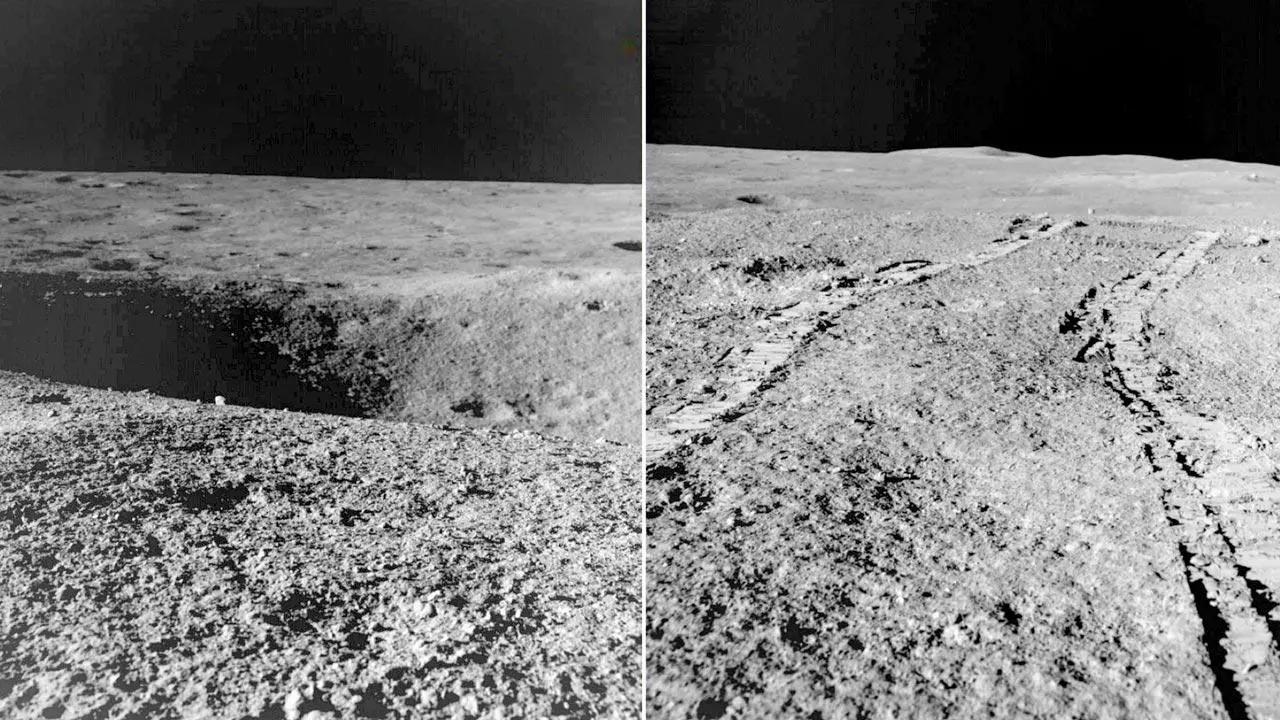Scientists expect to get new information about the past, present and future of the Sun after analysing the data that will be collected by India's first solar mission Aditya-L1, scheduled to be launched by ISRO on September 2

A combo of two photos shows a crater (left) that the Chandrayaan-3 Rover Pragyan encountered on August 27, and the path (right) retraced by it on the lunar surface. Pic/PTI
Scientists expect to get new information about the past, present and future of the Sun after analysing the data that will be collected by India's first solar mission Aditya-L1, scheduled to be launched by ISRO on September 2.
ADVERTISEMENT
This data is believed to be important to understand possible climatic changes on Earth in the decades and centuries ahead.
Aditya-L1 will go up to the First Lagrangian point, about 1.5 million km from the Earth, and transmit the data much of which will come to the scientific community for the first time from a platform in space, said solar physicist Prof Dipankar Banerjee, who is part of a team which conceptualised the mission more than 10 years ago.
"Our existence or life on Earth is basically because of the presence of the Sun which is our nearest star. All energy comes from the Sun. It is important to understand whether it is going to emit the same radiation (that it does now) or it is going to undergo changes.
"If the Sun does not radiate the same amount of energy tomorrow, it will have a very big impact on our climate," Banerjee told PTI.
If the Sun can be monitored over a long period from the Lagrangian point, it is expected to model the history of the Sun that is hitherto unknown to mankind, said the scientist who is the Director of Aryabhatta Research Institute of Observational Sciences (ARIES) in Nainital, an autonomous body under the Union government.
It has been seen that every 11 years, there is a change in the magnetic activity in the Sun, which is known as the solar cycle. There are also occasional violent changes in the magnetic field in the solar atmosphere resulting in huge bursts of energy which are called solar storms, Banerjee said.
The outer solar atmosphere, the corona, is structured by strong magnetic fields, which confines hot plasma. At certain times it releases into the interplanetary medium bubbles of gas and magnetic fields called coronal mass ejections, he said.
"When they travel in the interplanetary medium, they can go in all directions. Satellites are directly affected by the impact of the coronal mass ejections. Other planetary bodies, including the Moon, also get affected by solar storms. To protect our assets in space, prediction of space weather is required. The predictions can be improved with the help of data from Aditya-L1," he said.
The ISRO's spacecraft can also help scientists dig out the hidden history of the Earth's climate as solar activities have an impact on the planet's atmosphere.
"There have been many ice ages on the Earth. People still do not fully understand how these ice ages were created, and whether the Sun was responsible for them," he said.
Aditya-L1 will attempt to get an estimate of the magnetic field in the corona for the first time from a space platform.
"Besides, continuous monitoring of near ultraviolet flux from the Sun, certain properties of the solar wind (expansion of the Sun's outer atmosphere that emits particles) and some other issues will be done for the first time," he said.
Ground-based telescopes will also be used along with the payloads of Aditya-L1 from the vantage point of Lagrange 1 point to understand the activities of the Sun.
Observations from ground-based telescopes will be combined with Aditya's scientific findings to get a comprehensive view of what is happening in the solar atmosphere, particularly on the solar storm, from ARIES, Kodaikanal and Udaipur observatories.
Their observations will be crucial for a better understanding of the phenomenon, he said.
"Once the scientific payloads (inside Aditya-L1) start operations, we will be looking for data after the verification phase is over. A team will be involved with the scientific data analysis," Banerjee said.
Lagrangian points are where gravitational forces, acting between two objects, balance each other in such a way that the spacecraft can 'hover' for a longer period of time.
The L1 point is considered the most significant of the Lagrangian points, for solar observations, which were discovered by mathematician Joseph Louis Lagrange.
"Now we are getting a great opportunity to study the Sun from a full-fledged observatory in space, and also from the ground. It is a huge jump for the Indian astrophysics and solar physics community. This will give us new perspectives, new capabilities. We are looking forward to it," said the senior scientist.
This story has been sourced from a third party syndicated feed, agencies. Mid-day accepts no responsibility or liability for its dependability, trustworthiness, reliability and data of the text. Mid-day management/mid-day.com reserves the sole right to alter, delete or remove (without notice) the content in its absolute discretion for any reason whatsoever.
 Subscribe today by clicking the link and stay updated with the latest news!" Click here!
Subscribe today by clicking the link and stay updated with the latest news!" Click here!








